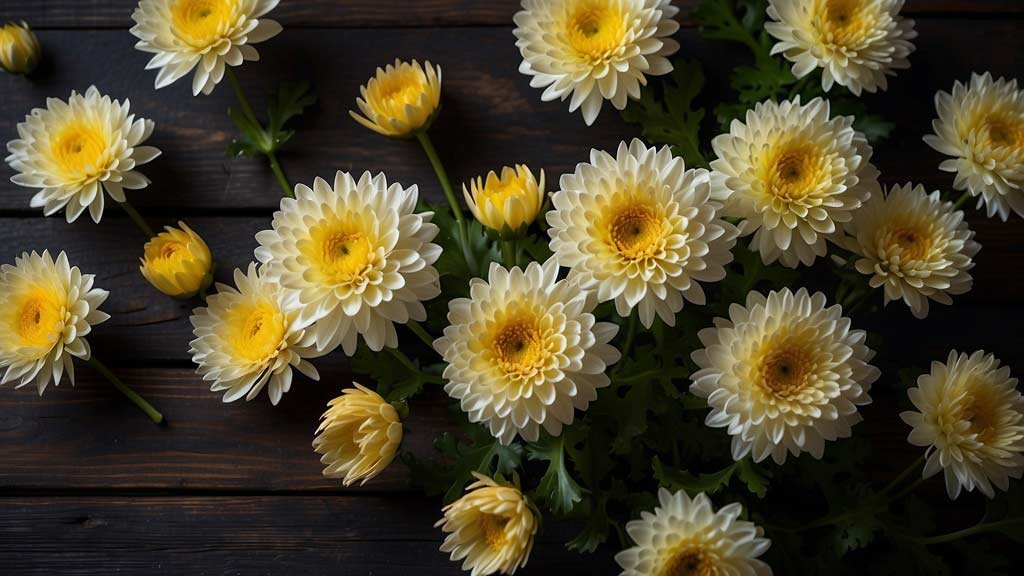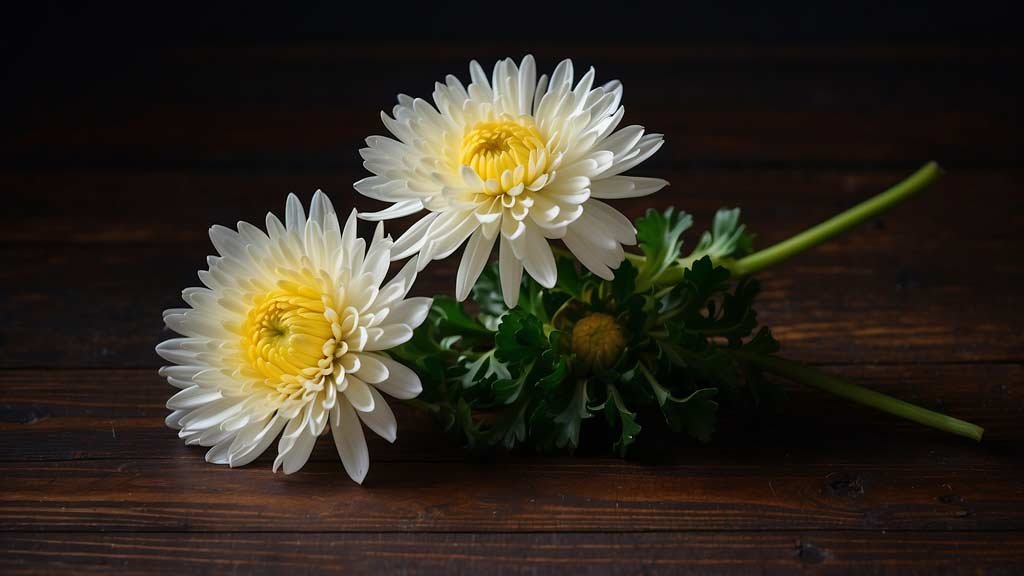The Quiet Power of Chrysanthemum
If you’ve ever sat down with a cup of golden chrysanthemum tea, you know it’s more than a simple herbal infusion. The flower has a way of brightening a room with its color, yet it brings a cooling calm to the body. Traditional Chinese Medicine (TCM) has praised chrysanthemum for centuries, describing it as a “cooling herb” that clears heat from the liver, soothes tired eyes, and strengthens the immune system.
The thing is, chrysanthemum isn’t just folklore. Modern research is beginning to confirm what ancient herbalists have long observed: this delicate flower carries antioxidant, anti-inflammatory, and antimicrobial compounds that make it far more than just a pleasant beverage.
Table of Contents
A Bit of History and Culture
Chrysanthemum (Chrysanthemum morifolium and Chrysanthemum indicum, mainly) has roots deep in East Asian culture. In China, it’s one of the “Four Gentlemen” of flowers, symbolizing nobility and integrity. In Japan, it’s tied to the Imperial family and represents longevity. For centuries, people didn’t just admire its blossoms in autumn gardens—they steeped them in hot water, added them to soups, and used them in medicine cabinets.
I remember a trip through Hangzhou, where street vendors offered cups of steaming chrysanthemum tea topped with a few floating petals. The locals didn’t drink it just for refreshment; they believed it kept the body balanced in the muggy summer heat. That subtle balance—between beauty and function—is what makes this herb special.
The Cooling Nature Explained
In TCM language, chrysanthemum is a cooling herb that clears “heat” from the body. Now, heat here doesn’t just mean temperature; it refers to states of inflammation, agitation, and overstimulation. You know those days when your eyes burn from too much screen time or when your body feels restless after greasy food? That’s the kind of imbalance chrysanthemum is said to correct.
Modern science interprets this cooling property as anti-inflammatory and antioxidant action. Flavonoids like luteolin and apigenin help reduce oxidative stress, which plays a role in everything from eye strain to weakened immunity.
Eyes Health
Let’s get practical. One of the most famous uses of chrysanthemum is for eye health.
- Eye Strain Relief: Long hours of computer work leave many of us with red, tired eyes. Chrysanthemum tea, especially when blended with goji berries, has been used traditionally to relieve that pressure and dryness.
- Vision Support: Its antioxidants, particularly lutein and zeaxanthin, are linked to protecting the retina and slowing age-related vision decline.
- Anti-inflammatory Action: Studies suggest extracts can reduce irritation, which explains why chrysanthemum washes or compresses are still used in folk remedies for sore eyes.
I once met an elderly man in Suzhou who swore by his daily ritual of chrysanthemum and wolfberry tea. He said it kept his eyesight sharp well into his eighties. Anecdotal, sure, but when tradition and modern nutrition science align, I tend to take note.
Immunity
Your immune system thrives on balance, and chrysanthemum seems to offer exactly that. Research shows chrysanthemum extracts have antimicrobial properties against certain bacteria and viruses. Pair that with its high antioxidant levels, and you’ve got a gentle ally against everyday immune challenges.
When I feel a tickle in my throat after long autumn walks, I’ll often brew a pot of chrysanthemum with a spoon of honey. The tea isn’t a magic bullet, but the soothing, cooling sensation feels like it steadies the body’s defenses.
Key Immune Benefits
- Supports the body’s natural response to infections
- Reduces inflammatory load on the immune system
- Provides antioxidants that protect immune cells from oxidative stress

Beyond Tea: Culinary and Medicinal Uses
While the tea is the most common form, it isn’t the only one.
- Soups and Stews: In Chinese cooking, dried chrysanthemum flowers are sometimes simmered in light broths to create a refreshing balance.
- Topical Applications: Infusions have been used to cleanse skin irritations.
- Capsules and Extracts: Modern herbal supplements concentrate chrysanthemum’s flavonoids for immune and anti-inflammatory support.
There’s even a subtle bitterness in the petals that some herbalists use to stimulate digestion. Bitter herbs often encourage the production of bile and digestive enzymes—something to keep in mind if you struggle with sluggish digestion after heavy meals.
The Science of Chrysanthemum Compounds
Chrysanthemum contains a range of bioactive compounds:
- Flavonoids like luteolin, apigenin, and acacetin, known for antioxidant and anti-inflammatory properties.
- Volatile oils that may have antimicrobial activity.
- Phenolic acids that help neutralize free radicals.
In lab studies, these compounds have shown potential to inhibit inflammatory pathways, protect liver cells, and even modulate blood pressure. While human trials are still limited, the consistency between traditional use and emerging data is worth noticing.
Safety and Considerations
Now, as with all herbs, moderation matters. Chrysanthemum is generally safe for most people when consumed as a tea. Still, a few points are worth keeping in mind:
- Those with ragweed or daisy family allergies may react to chrysanthemum.
- In rare cases, it might interact with blood-thinning medications.
- Excessive use could feel overly cooling for people who already run “cold” (in TCM terms)—think sluggish circulation or chronic fatigue.
When used mindfully, though, chrysanthemum is among the gentlest herbs you can bring into your routine.
Brewing the Perfect Cup
Brewing chrysanthemum tea isn’t complicated, but a few tricks can elevate the experience.
- Use about 5–6 dried flowers for one cup.
- Pour hot water (around 90°C, not boiling) over the flowers.
- Steep for 3–5 minutes until the water turns golden.
- Add a slice of rock sugar or honey if you like a sweeter taste.
- Try combining with goji berries or mint for added layers of flavor.
What you get is a light, floral tea that cools the mouth and soothes the senses. It’s one of those drinks that feels almost too simple for the depth it offers.
Daily Life
Chrysanthemum doesn’t demand grand rituals. It works best as part of daily life. A cup at your desk during long screen-heavy afternoons. A gentle brew in summer when the body feels overheated. A bedtime tea that clears the mind without the jolt of caffeine.
I often think of it as a friend that doesn’t insist on the spotlight but is always steady in the background. Not flashy, but reliable.
The Subtlety of Herbal Wisdom
Some herbs are dramatic. They act fast, and you notice their effects immediately. Chrysanthemum is subtler. It works by balancing, cooling, easing. It’s not about intensity—it’s about persistence. That’s why it’s been trusted for centuries: the benefits show up quietly, day after day.
When you sip this tea, you’re participating in a practice that stretches back through dynasties and across cultures. It’s not just about drinking flowers; it’s about remembering that health often thrives on gentleness, not force.
Article Sources
At AncientHerbsWisdom, our content relies on reputable sources, including peer-reviewed studies, to substantiate the information presented in our articles. Our primary objective is to ensure our content is thoroughly fact-checked, maintaining a commitment to accuracy, reliability, and trustworthiness.
- Chen, R., He, J., Tong, X., Tang, L., & Liu, M. (2019). Flavonoids from Chrysanthemum morifolium Ramat. and their health benefits: A review. Food Science & Nutrition, 7(7), 2466–2476. https://doi.org/10.1002/fsn3.1114
- Guo, L., Bai, S. P., Zhao, L., & Zhong, L. (2019). Antioxidant and anti-inflammatory activities of extracts from Chrysanthemum morifolium Ramat. Journal of Food Biochemistry, 43(5), e12899. https://doi.org/10.1111/jfbc.12899
- He, J., Chen, R., Chen, X., & Liu, M. (2018). Chrysanthemum morifolium and its bioactive compounds: From traditional uses to potential medicinal applications. Journal of Ethnopharmacology, 213, 132–146. https://doi.org/10.1016/j.jep.2017.11.037
- National Center for Complementary and Integrative Health. (2020). Herbs at a glance: Chrysanthemum. National Institutes of Health. https://www.nccih.nih.gov/
- Zhao, X., Wang, Q., Zhang, H., & Wang, L. (2017). Protective effect of Chrysanthemum morifolium extract against oxidative stress-induced retinal damage. Molecular Vision, 23, 873–883. https://www.molvis.org/molvis/v23/873
- Zhou, X., Seto, S. W., Chang, D., Kiat, H., Razmovski-Naumovski, V., Chan, K., & Bensoussan, A. (2016). Synergistic effects of Chinese herbal medicine: A comprehensive review of methodology and current research. Frontiers in Pharmacology, 7, 201. https://doi.org/10.3389/fphar.2016.00201

